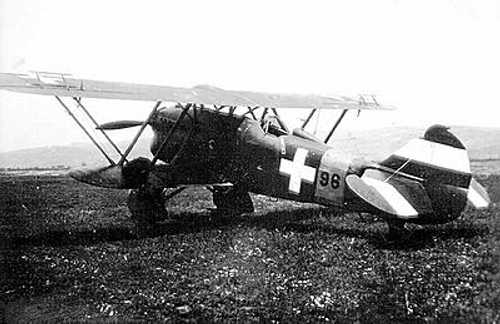
The Hungarian Air Force’s Fiat CR.32
Hungarian Air Force’s Fiat CR.32 with the insignias proposed late 1941 and finally approved and adopted on 12 March 1942. Hence this photo is after this date when this model of Italian fighter were already outdated and switched to non-active duties. Already customer of products of the Italian aeronautical industry, fighter Fiat CR.20 and bombers Caproni Ca-101 purchased late Twenty followed by the Fiat CR.30, the Hungary, following the Rome Protocol with Italy, in 1935, ordered a first batch of 26 Fiat CR.32 and a second batch of 26 more on 1936. This 52 fighters, armed with two Hungarian made 7.92mm M.GKH type Gebauer machine guns over the nose and synchronized with the propeller in place of the Italian Breda-SAFAT 12.7mm of the Regia Aeronautica’s planes, arrived in Hungary between 23 April and 2 December 1936. This aircraft was allocated to 1st Meteorological Group (a cover’s name because the not officially existence of a Hungary Air Force) of Hungarian Aviation Department (Magyar Légügyi Hivatal) moved from Szombathely to Székesfehervar. In 1938 the number of Hungarians CR.32 growth thanks the delivery by the Germany of 36 ex-Austrian aircraft of this types seized by the Luftwaffe after the Anschluss. In the same 1938 the existence of the Royal Hungarian Air Force (Magyar Királyi Honvéd Légierö or Honvéd Légierö) was officially disclosed and on 1 January 1939 the latter became an independent branch of the Magyar Armed Forces (Honvédség). The first commitment of Honvéd Légierö was during the Munich Crisis in October 1938 and on 25 October of this year the first fight of a Hungarian CR.32 occurred when the Föhadnagy (1st Lieutenant) László Pongrácz of 1/2. vadászszázad (Fighter Squadron) downed a Czech S-328 from 10 Squadron over Hodzovo (pilot, Corporal Ján Kello, wounded, observer, Aspirant Jaromir Sotola, killed). The Hungarian CR.32 was committed in combat also in the brief conflict (23 March to 4 April 1939) between the Hungary and the First Slovak Republic in Eastern Slovakia. After the clash the Hungarian pilots claimed seven Slovak aircraft, five Avia B-534 fighters and two Letov Š-328 recce/light bomber plane (confirmed by the Slovakian three Avia and both the Letov). The two CR-32 claimed by the Slovakian was not confirmed by the Hungarians. New commitment of the Honvéd Légierö’s CR.32 was the attack to Yugoslavia, side to Germans, from Hungarian territory on 6 April 1941; an unlucky balance, two CR.32 lost and one damaged in the clash with the Yugoslav Air Force. The last operational commitment of the Honvéd Légierö’s CR.32 occurred on first months of the German invasion of the Soviet Union. The Hungarian Air Force, already re-equipped with Fiat CR.42 and re-equipping with the Reggiane Re.2000, assigned the CR.32s to defence missions over the industrial cities of Miskolc and Diósgyör allocated to 1/1. Vadászszázad at Ungvár (now Ushgorod, Ukraine) and 1/2. Vadászszázad at Felsöábrány. On 4 July, 23 Fiat CR.32s of the 1/1. Vadászosztály moved to Miskolc, but soon after this aircraft, by now outdated, was removed from the front line and relegated to fighter training duties. Victor Sierra
This is a companion discussion topic for the original entry at https://ww2incolor.com/gallery/hungarian-forces/49076/the-hungarian-air-force's-fiat-cr.32
